RAINWATER HARVESTING
RAINWATER HARVESTING. Presented by Jack Holmgreen SparkleTap Water Company. About SparkleTap Water Company. Incorporated in 1997, SparkleTap Water Company Designs filtration systems for potable water Engineers harvesting systems for rainwater Stormwater management
Share Presentation
Embed Code
Link
Download Presentation
- water
- rainwater harvesting
- catchment area
- water budget
- sparkletap water company
- require alternate water source

thomasmoody + Follow
Download Presentation
RAINWATER HARVESTING
An Image/Link below is provided (as is) to download presentation Download Policy: Content on the Website is provided to you AS IS for your information and personal use and may not be sold / licensed / shared on other websites without getting consent from its author. Content is provided to you AS IS for your information and personal use only. Download presentation by click this link. While downloading, if for some reason you are not able to download a presentation, the publisher may have deleted the file from their server. During download, if you can't get a presentation, the file might be deleted by the publisher.
Presentation Transcript
- RAINWATER HARVESTING Presented by Jack Holmgreen SparkleTap Water Company
- About SparkleTap Water Company • Incorporated in 1997, SparkleTap Water Company • Designs filtration systems for potable water • Engineers harvesting systems for rainwater • Stormwater management • Active in water purification, water conservation and rainwater harvesting fields for over twenty years. • Provide purified water for potable use in public buildings • Currently supply water for potable and non-potable uses. Our projects have been funded by Economic Development Corporations, Water Districts and City Councils across Texas. • Founding member of American Rainwater Catchment Systems Association (ARCSA) and are committed to the future of rainwater technology.
- About SparkleTap Water Company (continued) • Level 3 Water Treatment Specialists licensed by the Texas Commission forEnvironmental Quality • Voting Member of the US Green Building Council (USGBC) • Rainwater Design Professionals certified by ARCSA • Member Irrigation Association
- Stormwater Recycling and Rainwater Harvesting • Rainwater harvesting and stormwater recycling are similar processes • Rainwater harvesting involves collecting water from cleaner surfaces • Stormwater recycling is designed to collect ground level runoff • Both require collecting, storing, and conserving rainwater runoff specifically for use at a later date • Many commercial systems combine rooftop and surface runoff in the same storage facility
- A Brief History of Rainwater Harvesting • Evidence suggests structures for holding rain water date back to 3,000 BC • Ancient cisterns have been discovered throughout the Mediterranean and Middle East • Native American rainwater harvesting systems can be found in Texas and Arizona • Rock cisterns in Texas known as the Hueco Tanks still remain • Tinajas in Arizona trapped rainwater for native dwellers
- Why Harvest Rainwater Today? • Reasons for harvesting and reusing rainwater include: • Self-sufficient water supply located close to the user • Produces soft water with low mineral content • Recharge groundwater supplies while reducing soil salt content • Mitigation of urban flooding • Reduce erosion caused by flooding • Control water quality • Health concerns (DBP’s) • Pollution • Deteriorating municipal water infrastructure • Cost efficient
- Components of a Rainwater Harvesting System • Before a rainwater harvesting system can be designed, several basic questions must be answered : • Retrofit existing building or use a new integrated system • System size – large, medium, or small • Complexity – passive, active or both • Cost – low cost or comprehensive • Intensity of use and level of commitment • Intended use – landscape irrigation and/or potable water. • Water quality required
- Retrofitting a Rainwater Harvesting System • Retrofitting an existing building or landscape generally is more costly than designing a new, integrated system • System must be designed to fit intended use, site conditions and supply demands • Systems can range in size from small to very large. • Small: 25,000 gallons.
- Types of Systems and Levels of Commitment • Systems can be complex or simple and active or passive • Complex systems can combine stormwater, greywater, potable and irrigation • Simple systems generally refer to landscape and infiltration only • Active systems require pipes, pumps, pressure tanks and filtration • Passive systems refer to use of drainage patterns, berms, basins and soil storage
- Types of Systems and Levels of Commitment • Four types of rainwater harvesting systems including: • 1. Occasional: Small storage capacity, some of users needs met, alternate water source required, uniform rainfall areas with fewer days between rainfall. • 2. Intermittent: Small to medium storage capacity, users needs met for part of the year, may require alternate water source, single rainy season. • 3. Partial: Medium to large storage capacity provides all of high quality water needs and some non-potable needs for at least the historic dry season, dependable and uniform rainfall occurring in one or two wet seasons. • 4. Full: Large storage capacity, users needs met for the whole year, no alternate water source available, requires strict monitoring and regulated use of water supply.
- Components of a Rainwater Harvesting System 1. Catchment area 2. Conveyance 3. Roof washing 4. Storage 5. Distribution 6. Purification
- Water Budget Analysis • A water budget analysis allows a designer to: • Determine how much rainwater can be collected by the project catchment area, including rooftop and ground level areas • Provide a supply and demand analysis on a monthly basis • Size the cistern(s) • Determine how much, if any, supplemental water is needed • Redesign a project to increase or reduce catchment area or storage to meet water demands • Four items are required to prepare a water budget: • Average annual rainfall data • A site plan • A landscape plan • Occupancy data
- Passive Rainwater Harvesting SystemsIntegrated Site Design • Integrated site design matches the site requirements with the collection components while improving the function and sustainability of the site • This process is based on a multidisciplinary approach • Evaluate opportunities to achieve multiple benefits • EXAMPLE: Above ground water tanks could provide stored water, shade, privacy screening, thermal mass and/or noise abatement
- Passive Rainwater Harvesting SystemsIntegrated Site Design continued • The goal of integrated site management is to spread, slow and infiltrate the stormwater runoff. • Integrated site design manages stormwater runoff at the top of the watershed • Multiple small volumes of water can be infiltrated into the site, decreasing the volume of water that drains toward one place at the bottom of the site watershed where it's harder to collect and manage • On-site watershed can be divided into multiple small basins by using existing depressions or reshaping the topography as needed • Overflows directed to rain gardens, gabions, pollution catch basins
- Passive Rainwater Harvesting SystemsIntegrated Site Design continued • Slowing and spreading the flow • Reduces erosion • Allows sediment and debris to drop out of the runoff, enriching soil in the water harvesting depressions. • Increasing soil surface area • Increases infiltration possibility • Allows water to be stored in the soil • The least expensive way to store stormwater • Stormwater stored in the soil should be in a location that supports plant life and does not damage built facilities • Areas where water is stored in the soil should be covered with a three to six inch layer of mulch to reduce evaporation and increase moisture retention • Excess water produced above the required needs can be directed to swales or infiltration fields
- Slowly Infiltrate Runoff • There are several ways to slowly infiltrate runoff including the following: • Microbasins • Ditches on-contour • Swales off-contour • French drains • Gabions • Infiltration fields/ponds • Rainwater harvested in rain gardens can fully support native plants
- Potable Rainwater Harvesting Systems • Collection of rainwater for potable uses is restricted to cleaner surfaces such as rooftops • The two most important components of potable collection: • Catchment surface • Metal roofs are preferred • Acceptable roofing also includes reinforced concrete, and plastic, fiberglass or composition shingles • Cement & clay tile is least desirable • Filtration • Clarification with floating intake • Cartridge pre-filter for sediment • Activated carbon for organics removal • Purification or disinfection for microbes
- Rainwater for Human Consumption • Rainwater is slightly acidic, which means it will dissolve and carry minerals into the storage system • First step should be to test the water collected from a catchment surface to determine its content • Rainwater intended for human consumption should undergo several cleansing steps including: • Screening • Settling • Filtering • Disinfecting
- Filtering Rainwater for Human Consumption • Filtering can include: • in-line or multi-stage cartridges • activated charcoal • reverse osmosis • chemical treatments • ultraviolet lights • ultra-filtration and/or ozonation • Water used from storage, • Sediment filtration should be a maximum of 5 micron sediment, followed by a nominal 0.5 micron carbon block filter or • An equivalent 1 micron absolute filter
- Filtering Rainwater for Human Consumption • Micro filters will remove Giardia and Cryptosporidium • Should be approved by the NSF for cyst removal • Ultra Filters can remove bacteria and viruses • Ultraviolet irridation can be used for this application • Turbidity must be low and rated flow must be observed
- Piping Design for Potable Systems • Only Schedule 40 PVC should be used • PE and polypropylene pipe is preferable • Coated aluminum, galvalum steel or plastic downspouts • No ABS and no DWV PVC pipe should be used • No recycled material should be used • No copper should be used
- Conclusion • Begin by reducing demand through conservation • Use native, adaptive or xeriscape plant materials • Create raingardens, berms and micro basins • Use sub-surface irrigation • Use High Efficiency Toilets (HET) or Ultra Low Flow (ULF) toilets • Use front-loading clothes washer • Install flow restrictors in faucets and shower heads • Consider greywater for irrigation • Locate tank(s) for multiple benefits
- Contact Information Jack Holmgreen SparkleTap Water Company 2951 Marina Bay Dr, Ste. 130-199 League City, TX 77573 email: jholmgreen@sparkletap.com http://www.sparkletap-rain.com 713-823-6126
- Rainwater System Overview

Rainwater harvesting,
Although I work for the Government, the views expressed in this presentation are entirely MY OWN and are NOT to be taken as the official views of Government of India.. . Falling ground water levels in several parts of India and other Asian Countries is a mater of serious concern.. Several steps are
536 views • 27 slides

Rainwater Harvesting
Rainwater Harvesting. CORK GLASS LTD. Introduction. Cork Glass have 8 machines that use either fresh or recycled water as a coolant as part of the production process. This created a demand that outweighed the public supply. Harvested rainwater can be used for all non drinking water uses.
338 views • 10 slides

Rainwater Harvesting Training Products
Rainwater Harvesting Training Products. Rainwater Management Solutions. How to use Harvested Rainwater? . Nonpotable Building washing Cooling towers Fire suppression Household cleaning Irrigation Laundry washing Pool/pond filling Toilet flushing Vehicle washing. Potable
489 views • 25 slides

Rainwater Harvesting System (RHS)
Rainwater Harvesting System (RHS) . Jean Pierre Nshimyimana , SM Civil and Environmental Engineering, MIT 2010. System Overview . Technical Analysis . Rainfall data Estimate the water demand and the storage capacity Comparison : Rainwater collected and water demand
488 views • 22 slides
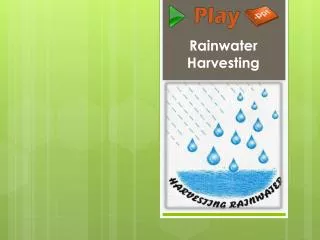
Rainwater Harvesting
Rainwater Harvesting. Introduction. Rainwater Harvesting is a technology used for collecting and storing rainwater from rooftops, the land surface or rock catchments. This technique usually found in Asia and Africa arise from practices employed by ancient civilizations. History.
2.82k views • 10 slides
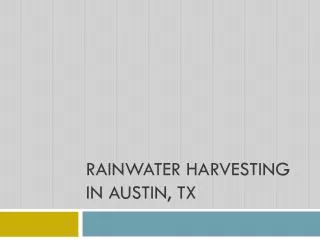
Rainwater Harvesting in Austin, TX
Rainwater Harvesting in Austin, TX. Outline. Describe interest in rainwater harvesting Estimate potential collection area Use precipitation data Estimate collected volume. Rainwater Harvesting. Only cost is personal system maintenance Rainwater has very low hardness
305 views • 12 slides

WHAT IS RAINWATER HARVESTING??
WHAT IS RAINWATER HARVESTING. Collection of clean FREE rainwater from our roof that would otherwise be going “ down the drain ” Rainwater is re-used through the dwelling by means of a pump and automatic rainwater controller.
1.6k views • 17 slides

Rainwater Harvesting A Presentation
Rainwater Harvesting A Presentation. “Water, water everywhere but not a drop to drink”. This could soon be true in India as most of the cities face a water crisis today due to irregular rainfall, a growing population and rapid urban development.
615 views • 29 slides

Rainwater Harvesting For Decision Makers
Rainwater Harvesting For Decision Makers. Environment and Water Resource Department February 2008. What Is Rainwater Harvesting?.
932 views • 32 slides

RAINWATER HARVESTING
RAINWATER HARVESTING. A Solution for survival. Outline of the Presentations. Introduction to water Movement of water Water Conservation & Rainwater Harvesting Methods Water recharge-recycle-reuse. THE PLANET "AQUA". WATER AND LAND. The Earth is covered with WATER and LAND.
1.02k views • 53 slides

RAINWATER HARVESTING
RAINWATER HARVESTING. DOES IT HAVE A FUTURE?. S E WIELEBSKI MSc (Dist) CEnv PEng FCIOB FBEng MSPE ACIArb FRSA DIVISIONAL DEVELOPMENT DIRECTOR. RAINWATER HARVESTING DOES IT HAVE A FUTURE?. A few thoughts to set the scene A little bit of history A review of RWH from a Developers perspective
432 views • 19 slides

Rooftop Rainwater Harvesting
Rooftop Rainwater Harvesting. Pre-implementation guide for schools. At the city level Reduces water demand Reduces energy demand – lesser energy required for water distribution Improves groundwater situation
574 views • 19 slides

Rainwater Harvesting
Rainwater Harvesting. Owen Edgerton September 25, 2006. History. Developed independently across the continents India 1000BC simple stone structures for harvesting rainwater China Loess plateau ~ 0AD Rainwater wells and Jars. http://www.irpaa.org.br/colheita/02.htm#1.
497 views • 18 slides

Rainwater Harvesting
Rainwater harvesting is a water storage technique in which on-ground or under-ground tanks are used to store rainwater. You can use this water for regular activities like car washing or watering the garden etc.
1.51k views • 6 slides

Rainwater Harvesting Market
By Report, Rainwater Harvesting Market expect to grow a CAGR of 5.8% upto 2025 Globally, Based on Type of Technique (Surface Run-Off Harvesting, Rooftop Rainwater Harvesting), Application and Geography
131 views • 8 slides
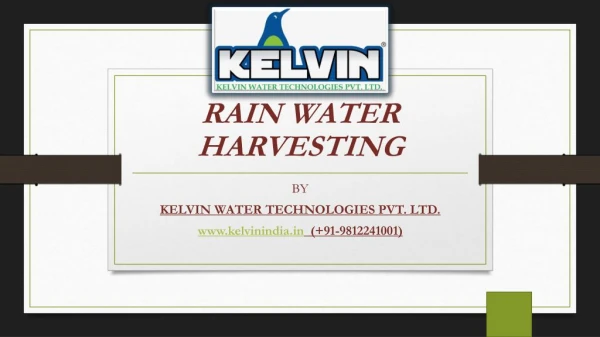
Rainwater Harvesting Plant System
Rainwater harvesting is the accumulation and storage of rainwater for reuse on-site, rather than allowing it to run off. Rainwater can be collected from rivers or roofs, and in many places, the water collected is redirected to a deep pit (well, shaft, or borehole), a reservoir with percolation, or collected from dew or fog with nets or other tools. Its uses include water for gardens, livestock, irrigation, domestic use with proper treatment, indoor heating for houses, etc.
235 views • 14 slides

Rainwater harvesting system
The usefulness of rainwater harvesting is undoubtedly unquestionable but people are still skeptical about it now this is because some people think that the quality of the water as saved from rain would not be that suitable for everyday use. The water harvested from rain may not be efficient enough in meeting the purposes and activities. The activities hinted are however include bathing, drinking and cooking. Now this can be true to some extent but the water can very well be used for agricultural usage and different non-critical purposes.
130 views • 8 slides
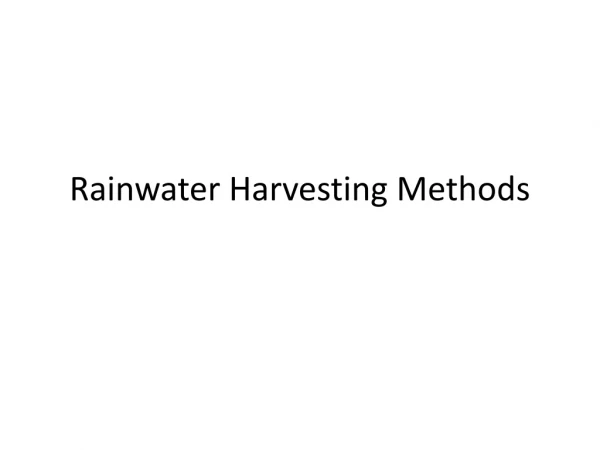
Rainwater Harvesting Methods
Rainwater Harvesting Methods. What do we need to do with water?. Slow it, Spread it, Sink it!. Brad Lancaster: “Rainwater Harvesting for Drylands and Beyond”. The 8 Principles of Successful Rainwater Harvesting. Berm and Basin. Good for planting trees in!. Planting microbasins. Mulching!.
941 views • 87 slides

Rainwater harvesting systems
The rainwater harvesting systems and packages on this page contain everything you will need if you wish to install a rainwater harvesting system, including water butt, diverter, filter and pump. If you would prefer to buy each of these components separately, visit the corresponding pages in this section using the menu. For those new to the field, it may be easier to buy a package which includes all you need rather than having to decide on each component individually.
194 views • 8 slides

Rainwater Harvesting
Rainwater Harvesting. CORK GLASS LTD. Introduction. Cork Glass have 8 machines that use either fresh or recycled water as a coolant as part of the production process. This created a demand that outweighed the public supply. Harvested rainwater can be used for all non drinking water uses.
203 views • 10 slides
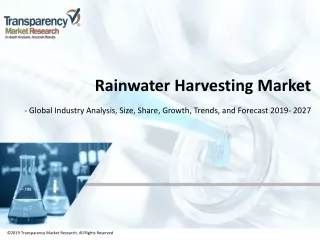
Rainwater Harvesting Market
Rainwater Harvesting Market
148 views • 5 slides























